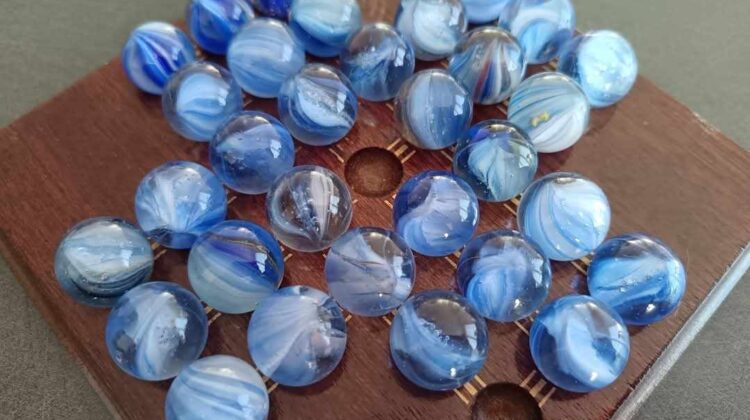
by Stéphane Balasa, Osny France
All Photos Courtesy of Stéphane Balasa
All of you who read our stories regularly will remember Stéphane Balasa, who lives in Osney (which is in the Région Île de France & not far from Pontoise). He contributed to the story “Notes From A Gifted Marble Polymerist.” Stéphane continues to make his polymer marbles which are exciting and vibrant and he tell us that “I make polymer marbles among other things.” He is a gifted marble artist.
We were very happy when Stéphane wrote to us again and sent information for a new story! One note: Stéphane wrote the story in French and we are solely responsible for any miss-translation or miss-interpretation. Below you will find both his text for the story and our editorial comments. We hope that you will enjoy reading his story; it will certainly be surprising to many marble “old timers” and blow them right out of international waters!

Stéphane: In France, the hobby of collecting marbles is not at all popular; the very rare exhibitions and books on the subject were produced by Corrine Jacquemin[1]. Today it excites different artisans of glass marbles, but mainly for international destinations. A few rare collectors exist in Belgium, Holland, and France to name but a few. But, while France did produce clay marbles, there has never been an industrial manufacturing of glass marbles in France.
Stone marbles can be exclusively dated to the late 18th century when they were imported by the Alsatians[2] for the sake of materials to be added to cement. Later they were imported as an agglomerate of sand and cement.
Mirabel & Blacons, an old clay marbles factory, closed in 1982. The oldest, and the first clay marble maker in France, Billes en Brousse, was also the last French clay marbles factory to close its doors in 2015.
Billes en Brousse started as a clay marble factory in 2009 and went into liquidation in 2017. It was a factory that only manufactured clay marbles…but never any glass marbles. Today, it is still in operation, but under a different name, and mainly produces wooden toys. Very few clay marbles. They are trying to innovate with new colors. But glass marbles have definitely taken over around the world. That’s why collecting glass marbles is not a hobby in France, because there have never been large glass marble factories like in the United States.
There is still a craftsman in the Vosges, but more focused on the manufacture of wooden toys. That’s why I think all the glass marbles were imported. Here are some French-labeled Vitro Marbles, but they say “Made in the USA” on them[3]. That’s why I think all glass marbles were imported.
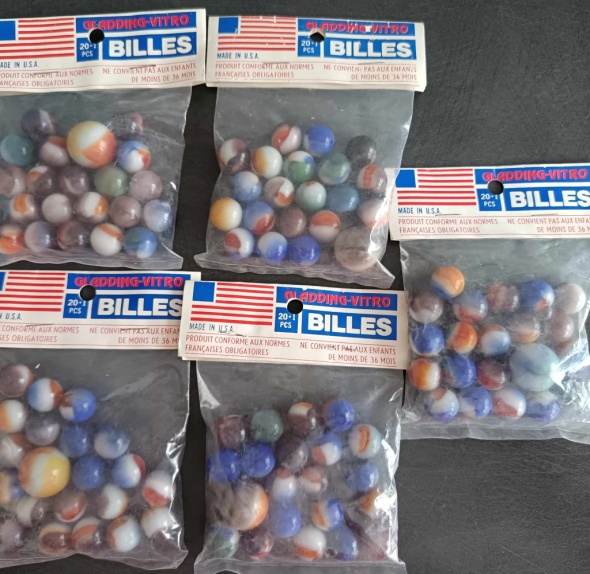
When I studied the so-called French Sparklers I realized that they strangely resemble Akro Sparklers. I asked myself the question, do they come from the United States?
This image shows a Monick Marbles box (sparklers marbles). Although the label is in French, the Monick store, which was located in Paris, only made wooden toys. It did not make glass marbles. Today the store no longer exists. It has become a restaurant instead. Unfortunately none of the Sparklers bag labels mention their origin.
Here another Monick brand and again no provenance. Not here either, but interestingly for me, the label is written in French, but the rest of the packaging has very American connotations, especially the image of the child!
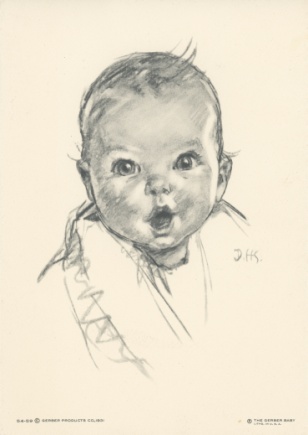

Above is a lithograph of an original drawing by Dorothy Hope Smith
Editors: The French text on this poly bag reads “Little one’s toys”. To us this also “sounds like” an American sentiment. Many of us think of the American “Gerber baby.” when we see this image.[4]
Editors: Take a long moment and look at these gorgeous marbles! Packaged without any hint of a maker! Finally, check out the odd staples on the header.
Stéphane:
Look at these large sparklers. The Caltex[5] brand is American. However, the bags are marked in French “offered”. Very interesting fact here. This bag was offered at gas stations to people who came to buy gas.
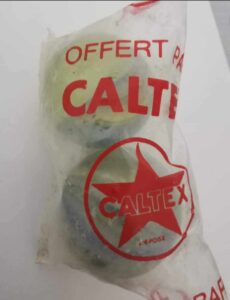

Some bags have been opened, and they all look like Sparklers. So I sincerely believe that the “French Sparklers” featured below were made in the United States but in a simpler way, that is to say, less colored glass to limit manufacturing costs, since the American Akro Sparklers are vibrant in color and well filled with vanes.
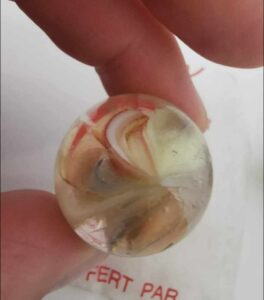
The two images below are“Caltex” marbles out of the poly bag.
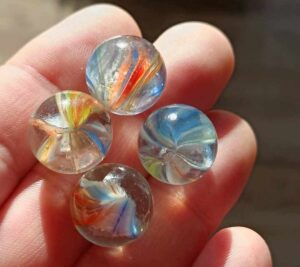
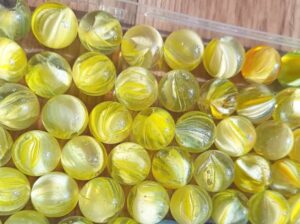
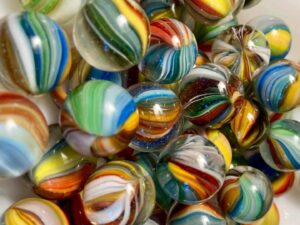
In France, we don’t find any variations on Vitro agates. There are no Vitro Tigers, Conquerors, Black Lines, etc.; only the classics were imported into France. I think the same was true of Sparklers.
Only Sparklers with less vivid colors and with less thick vanes were imported into France, the Akro Sparklers USA being premium were intended for Americans and future collectors. This is why I think the marbles hobby did not go further here in France, because they never had any manufacture of glass Marbles in a way.
Here is the source: “For a century, a marble mill operated in Blacons in the Drôme region[6]. It indirectly provided a living for the surrounding farmers who cut small cubes of stone for its operation. It was a distant testament to the forced exile of the Alsatians and Lorrainers, since it was an Alsatian who founded it, shortly after his flight following the French defeat against Prussia in 1871.” Watch this video: https://www.youtube.com/watch?v=Whd7Gv2QGwg
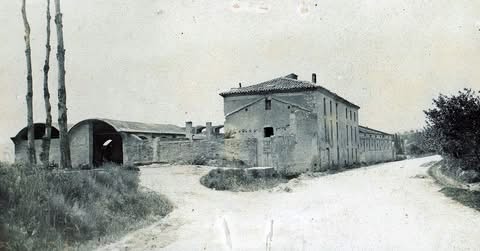
Unfortunately, the Youtube video is in French. However, the gentleman explains, with supporting documents, that to his knowledge, in France they only manufactured clay marbles; there was never any industrial production of marbles in France, and perhaps not even in Europe. I emphasize the word industrial. Production in large quantities.
Editors: Stéphane put a good deal of time, research, and energy into this story and it is a revelation to us. This story contains ideas which we had never considered before and we are confident that it makes a solid contribution to the history of marbles and marble making. He has convinced us! We believe that these ideas could only originate in France and not in America.. We now close with some more fascinating photos which Stéphane sent.
Gallery
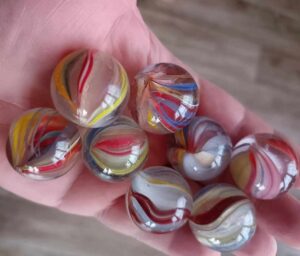


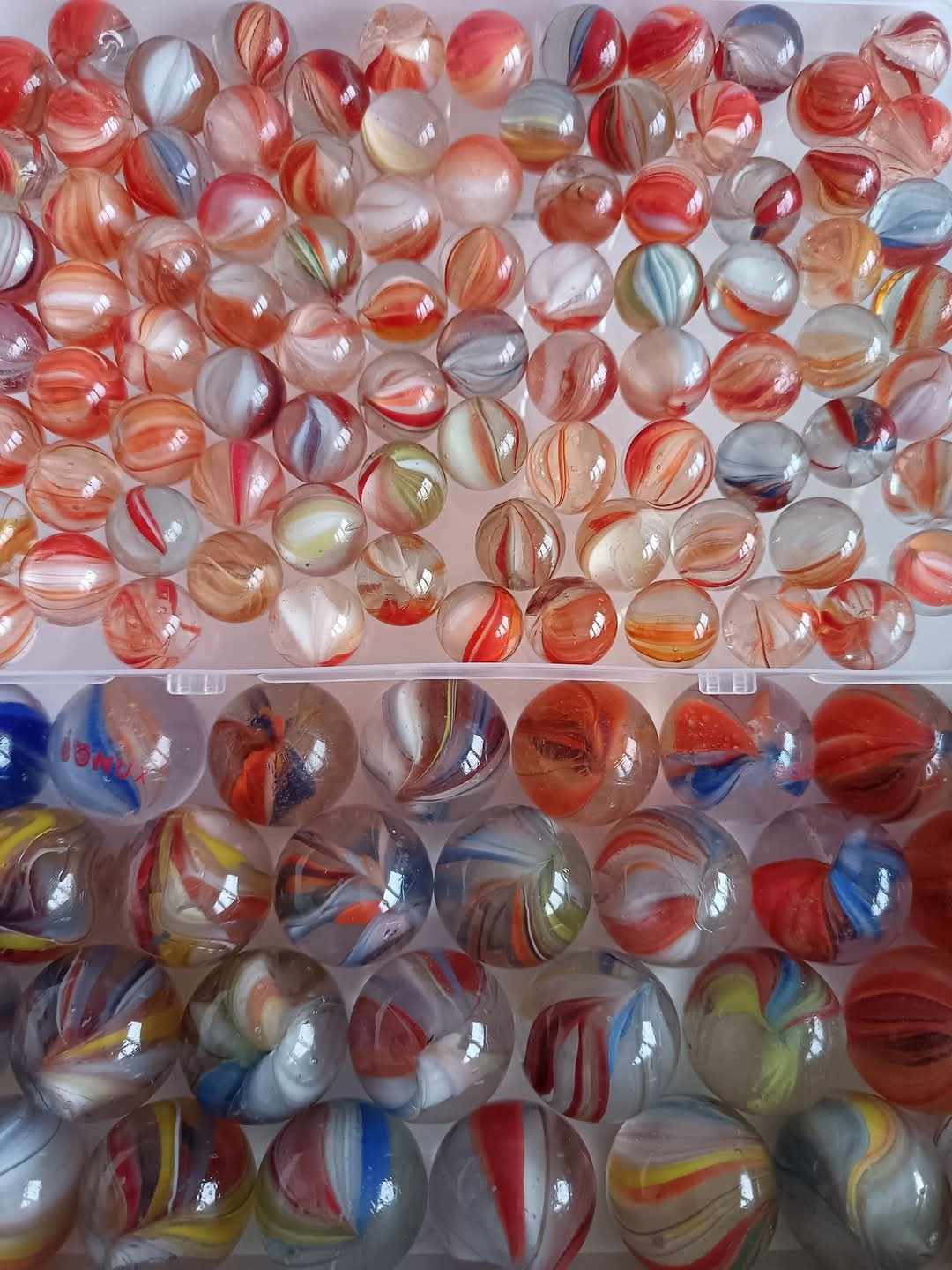
Editors: We introduced Ms. Jacquemin when we emailed her while researching our story “French Marble Triangles” (https://thesecretlifeofmarbles.com/french-marble-triangles1/). In 1982 her 63 page book Tous les jeux de billes (All Aboput Marbles) was Volume 18 of L’ours de poche (The Pocket Bear/ Editions Buissonières). The Pocket Bear is published by Gallimard who has published in Paris since 1911. - Editors: AI tells us that Alsatians is the proper name of the inhabitants of Alsace which is a region in northeastern France. Alsace has a rich history, having been influenced by both French and German cultures due to its location near the border. The people of Alsace are known for their unique traditions, cuisine, and dialects. ↑
- Editors: Quick question: Have you ever considered whether or not American companies shipped bulk marbles to foreign buyers who packaged them or did American companies provide & apply the headers? ↑
- This is a lithograph of an original drawing by Dorothy Hope Smith. https://upload.wikimedia.org/wikipedia/commons/0/08/Gerber_Baby_%281931_litho%29.jpg/ (5/8/2025); https://commons.wikimedia.org/wiki/File:Gerber_Baby_(1931_litho).jpg?uselang=en#Licensing/ 5/8/2025 ↑
- Editors: Caltex is a name most widely recognized as a major American petroleum brand with a lengthy history in the global oil and gas industry. Originally established on June 30, 1936, the company began life as the California Texas Oil Company—an innovative joint venture between Standard Oil of California (which would later become Chevron) and The Texas Company (Texaco) . Over the decades, Caltex evolved through several name changes and organizational restructurings, reflecting the dynamic nature of international energy markets. You might want to check https://www.caltexus.com/ (4/7/2025) & https://www.caltex.com/sg/en.html 4/7/2024 ↑
- Blacons is part of the commune of Mirabel-et-Blacons, located in the Drôme department of southeastern France. This area is known for its picturesque landscapes, including the Drôme River and the iconic “3 Becs” mountain peaks. Historically, Mirabel was a fortified medieval village, and Blacons developed later as an industrial hub with a papermaking factory in the 19th century. https://www.francethisway.com/places/a/mirabel-et-blacons-drome.php (4/9/2025) & https://www.drome-cestmanature.com/fiches/mirabel-et-blacons/ 4/9/2025 ↑

